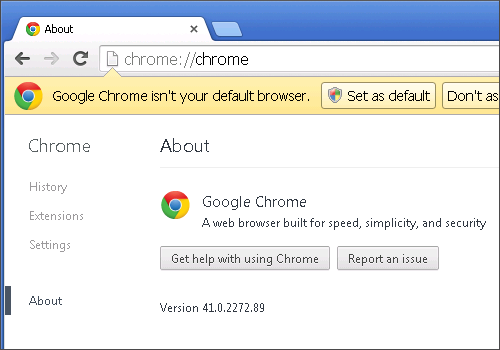Yesterday Google Chrome team released the stable version of Chrome 41 on Windows, Mac and Linux. We got a notification of the new release and within a few hours added Chrome 41 to Browserling. The new Chrome 41 browser is now available to all our paying and free customers.

Try Chrome 41 in Browserling now!
Significant changes in Chrome 41:
- A number of new apps/extension APIs.
- Lots of under the hood changes for stability and performance.
Significant changes in Android version of Chrome 41:
- The ability to pull to reload at the top of most pages.
- A number of bug fixes and performance improvements.
Chrome 41 adds the following new features:
- 'any-pointer' and 'any-hover' Media Queries - Media queries for determining capabilities of a UA's pointer devices.
- Blending of HTML and SVG elements - Provides a way to blend an HTML or SVG element with its backdrop. The CSS properties: mix-blend-mode and isolation.
- ES6 numeric literals - Allows binary and octal numeric literals using 0b and 0o prefixes such as 0b101 and 0o753 respectively.
- Lexical Declarations (ES6) - 'let' and 'const' declarations define variables/constants with block scoping.
- Template Strings (ES6) - Template strings are string literals allowing embedded expressions.
- WebAudio: StereoPannerNode - StereoPannerNode is a audio processing node which positions an incoming audio stream in a stereo image using robust equal-power panning algorithm and sample-accurate automation. Web Audio API specification has been updated to include a new audio node dedicated to equal-power stereo panning.
- WebAudio: suspend/resume - Supports suspending and resuming an AudioContext to allow applications to pause the audio device when needed. This reduces CPU usage and power consumption when audio is suspended.
- image-rendering: pixelated - "image-rendering: pixelated" indicates that image should be scaled "so that the image appears to be simply composed of very large pixels", e.g. using nearest-neighbour.
The new release also includes 51 security fixes. Google highlighted the following fixes that were contributed by external researchers:
- CVE-2015-1232: Out-of-bounds write in media. Credit to anonymous.
- CVE-2015-1213: Out-of-bounds write in skia filters. Credit to cloudfuzzer.
- CVE-2015-1214: Out-of-bounds write in skia filters. Credit to cloudfuzzer.
- CVE-2015-1215: Out-of-bounds write in skia filters. Credit to cloudfuzzer.
- CVE-2015-1216: Use-after-free in v8 bindings. Credit to anonymous.
- CVE-2015-1217: Type confusion in v8 bindings. Credit to anonymous.
- CVE-2015-1218: Use-after-free in dom. Credit to cloudfuzzer.
- CVE-2015-1219: Integer overflow in webgl. Credit to Chen Zhang (demi6od) of NSFOCUS Security Team.
- CVE-2015-1220: Use-after-free in gif decoder. Credit to Aki Helin of OUSPG.
- CVE-2015-1221: Use-after-free in web databases. Credit to Collin Payne.
- CVE-2015-1222: Use-after-free in service workers. Credit to Collin Payne.
- CVE-2015-1223: Use-after-free in dom. Credit to Maksymillian Motyl.
- CVE-2015-1230: Type confusion in v8. Credit to Skylined working with HP's Zero Day Initiative.
- CVE-2015-1224: Out-of-bounds read in vpxdecoder. Credit to Aki Helin of OUSPG.
- CVE-2015-1225: Out-of-bounds read in pdfium. Credit to cloudfuzzer.
- CVE-2015-1226: Validation issue in debugger. Credit to Rob Wu.
- CVE-2015-1227: Uninitialized value in blink. Credit to Christoph Diehl.
- CVE-2015-1228: Uninitialized value in rendering. Credit to miaubiz.
- CVE-2015-1229: Cookie injection via proxies. Credit to iliwoy.
Happy cross-browser testing in Chrome 41!
Email this blog post to your friends or yourself!
Try Browserling!
Enter a URL to test, choose platform, browser and version, and you'll get a live interactive browser in 5 seconds!



 Subscribe to updates!
Subscribe to updates!
 BizSpark
BizSpark